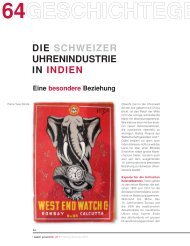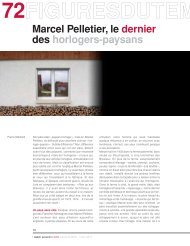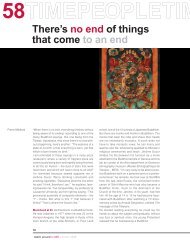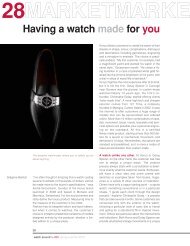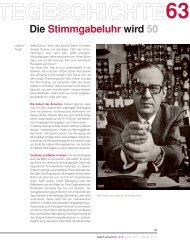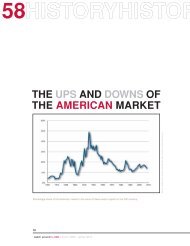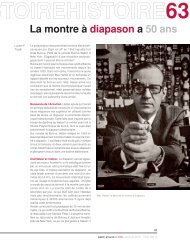The watch that tells the time around the globe - Watch Around
The watch that tells the time around the globe - Watch Around
The watch that tells the time around the globe - Watch Around
Create successful ePaper yourself
Turn your PDF publications into a flip-book with our unique Google optimized e-Paper software.
32SPECIALREPOR<br />
<strong>The</strong> <strong>watch</strong> <strong>that</strong> <strong>tells</strong><br />
<strong>the</strong> <strong>time</strong> <strong>around</strong> <strong>the</strong> <strong>globe</strong><br />
© Fondation de la Haute Horlogerie, Musée International d’Horlogerie<br />
Among <strong>the</strong> ancestors, <strong>the</strong> Rouzier & Melly <strong>watch</strong> of <strong>around</strong> 1780 (left) gave <strong>the</strong> local <strong>time</strong>s of 53 towns. <strong>The</strong> 1885<br />
“sphéromètre” (centre) signed by J. L. & A. Béguelin in Tramelan, Switzerland, shows 25 towns in front and 43 on <strong>the</strong><br />
back. On <strong>the</strong> right, <strong>the</strong> Achille Hirsch <strong>watch</strong> of <strong>around</strong> 1900 displayed <strong>the</strong> 6 major local <strong>time</strong>s surrounding Paris on <strong>the</strong><br />
front and no fewer than 140 o<strong>the</strong>rs on <strong>the</strong> back.<br />
Jean-Philippe Arm<br />
Whe<strong>the</strong>r <strong>the</strong>y’re called World Time or Universal<br />
Time <strong>watch</strong>es, <strong>the</strong> kind <strong>that</strong> permanently shows <strong>the</strong><br />
<strong>time</strong> in all 24 <strong>time</strong>zones designated by as many or<br />
more localities can boast a most useful complication<br />
and a distinguished horological pedigree. <strong>The</strong>y<br />
take you back in history, to <strong>the</strong> age of exploration,<br />
long journeys and <strong>the</strong> quest for a seaworthy <strong>time</strong>piece,<br />
accurate enough to give you longitude. <strong>The</strong>y<br />
tell how nations agreed on a common reference<br />
from which to slice <strong>the</strong> global orange into 24 mostly<br />
equal and geopolitically acceptable segments.<br />
<strong>The</strong> most eloquent models are based on a mechanism<br />
dating from <strong>the</strong> 1930s, and any new versions<br />
are bound to attract attention – like <strong>the</strong> World Time<br />
model presented in Geneva at <strong>the</strong> SIHH luxury<strong>watch</strong><br />
salon in January by a local brand, Vacheron<br />
Constantin. <strong>The</strong>re was no lack of competition in this<br />
winter market spread between <strong>the</strong> official salon and<br />
an increasing density of fringe stalls. It’s not easy to<br />
stand out among <strong>the</strong> amazing gadgetry, artwork<br />
and craftsmanship, let alone <strong>the</strong> crazy ideas and<br />
original concepts <strong>that</strong> struggle for centre stage.<br />
<strong>The</strong>n you have to face Baselworld two months later,<br />
when <strong>the</strong> pressure is even greater.<br />
<strong>The</strong> status enjoyed by this geographic <strong>time</strong> indication<br />
is remarkable considering <strong>that</strong> it is not classified<br />
among <strong>the</strong> great complications, although it is<br />
regarded as a somewhat rare classic. This relative<br />
modesty did not however stop an old World Time<br />
model signed by <strong>the</strong> Geneva company, Patek<br />
Philippe, (ref. 1415 in platinum) from breaking <strong>the</strong><br />
price record for wrist<strong>watch</strong>es at an auction in 2002:<br />
6.6 million Swiss francs. Ano<strong>the</strong>r model in gold with<br />
an enamel dial from <strong>the</strong> same year, 1939, was sold<br />
for a bid of 2.7 million. Such cash values, which are<br />
due to a number of factors, magnify <strong>the</strong> fascination<br />
of <strong>the</strong> World Time <strong>watch</strong>. Besides, it has <strong>the</strong> right<br />
cultural and scientific associations to confer <strong>the</strong><br />
utmost respectability.<br />
<strong>The</strong> international agreement <strong>that</strong> fixed <strong>the</strong> Greenwich<br />
meridian as <strong>the</strong> prime meridian followed <strong>the</strong><br />
Washington conference of 1884. It brought toge<strong>the</strong>r<br />
32<br />
| <strong>watch</strong> <strong>around</strong> no 011 spring-summer 2011
TSPECIALREPORT<br />
representatives of <strong>around</strong> 25 countries, but it took<br />
several decades before Greenwich Mean Time was<br />
widely adopted as <strong>the</strong> <strong>time</strong> standard. Even today<br />
<strong>the</strong>re are local <strong>time</strong>s <strong>that</strong> insist on differing from<br />
GMT by a half or a quarter of an hour. Switzerland<br />
aligned its Bern mean <strong>time</strong> with central European<br />
<strong>time</strong>, 15° East of Greenwich or GMT+1.<br />
Gallic pique. Such honour given to <strong>the</strong> Royal<br />
Observatory in Greenwich went down badly with<br />
<strong>the</strong> French whose Paris Observatory was three<br />
years older. France stood by <strong>the</strong> Paris Meridian.<br />
Britain suggested it might adopt <strong>the</strong> metric system<br />
– one of <strong>the</strong> glories of <strong>the</strong> French Revolution – if<br />
<strong>the</strong> French succumbed to Greenwich. France gave<br />
up its nine minutes of difference, joining its<br />
European neighbours in 1911, when it accepted<br />
<strong>the</strong> Greenwich prime meridian. Britain never kept<br />
its side of <strong>the</strong> undertaking.<br />
That historical footnote reveals <strong>the</strong> symbolic importance<br />
and national susceptibilities involved in such<br />
issues. It should be remembered, however, <strong>that</strong><br />
<strong>the</strong> United States refrained from imposing an<br />
American meridian, although it was keen to have a<br />
<strong>time</strong> standard for its growing railways. <strong>The</strong> main<br />
advantage of <strong>the</strong> European 0 meridian is <strong>that</strong> it<br />
would put <strong>the</strong> 180° meridian for <strong>the</strong> date change at<br />
midnight through <strong>the</strong> middle of <strong>the</strong> Pacific.<br />
Never<strong>the</strong>less, adopting GMT meant following <strong>the</strong><br />
British habit of starting <strong>the</strong> day at noon. Thus <strong>the</strong><br />
morning ended one day at 0 hours GMT and <strong>the</strong><br />
afternoon started <strong>the</strong> next. It took almost a century<br />
to correct this cultural aberration with <strong>the</strong> introduction<br />
of UTC – Coordinated Universal Time – in<br />
1972. Today’s <strong>time</strong> reference is based on <strong>the</strong> mean<br />
frequencies of 200 atomic clocks, and it starts <strong>the</strong><br />
day at midnight.<br />
From <strong>the</strong> archives: Louis Cottier’s job application to<br />
Charles Vacheron dated August 31, 1930.<br />
© Vacheron Constantin, Patek Philippe<br />
Master Cottier. It also took <strong>time</strong>, though not as<br />
long, before <strong>the</strong> <strong>watch</strong> industry took an interest in<br />
<strong>time</strong> beyond a local zone. In <strong>the</strong> early 1930s<br />
an independent <strong>watch</strong>maker in Carouge, near<br />
Geneva, devised a clever mechanism <strong>that</strong> gave <strong>the</strong><br />
<strong>time</strong> in all <strong>time</strong>zones on a single dial at a glance.<br />
Louis Cottier thus became <strong>the</strong> pivotal figure in any<br />
research into this <strong>watch</strong>making speciality. His work<br />
unavoidably leads to <strong>the</strong> Vacheron Constantin<br />
33<br />
<strong>watch</strong> <strong>around</strong> no 011 spring-summer 2011 |
SPECIALREPORTS<br />
World Time model, <strong>the</strong> latest reincarnation of <strong>the</strong><br />
Cottier system.<br />
<strong>The</strong> idea of showing different local <strong>time</strong>s is not<br />
new. Those big 19th-century pocket-<strong>watch</strong>es with<br />
an arrangement of subdials for <strong>the</strong> <strong>time</strong>s in major<br />
capitals are quite common in auction and exhibition<br />
catalogues. An exhibition of <strong>the</strong> Beyer collection<br />
at <strong>the</strong> last SIHH luxury-<strong>watch</strong> salon in Geneva<br />
featured a <strong>time</strong>piece made in 1780 with <strong>the</strong> names<br />
of 53 towns <strong>around</strong> a 24-hour disc rotating anticlockwise.<br />
This is certainly an ancestor of <strong>the</strong><br />
Cottier solution, made by Rouzier and Melly, two<br />
Geneva <strong>watch</strong>makers. A couple of steps away was<br />
ano<strong>the</strong>r cousin in <strong>the</strong> World Time genealogy<br />
among <strong>the</strong> 270 pieces of <strong>the</strong> Cartier exhibition. It<br />
showed <strong>the</strong> <strong>time</strong> in <strong>around</strong> 50 localities. One must<br />
remember <strong>that</strong> before 1884 <strong>the</strong>re were hundreds<br />
of local <strong>time</strong>s.<br />
<strong>The</strong> decisive emergence of <strong>the</strong> World Time <strong>watch</strong><br />
in <strong>the</strong> 1930s is attributed to <strong>the</strong> growing importance<br />
of air travel and telecommunications. Louis Cottier’s<br />
invention came at just <strong>the</strong> right <strong>time</strong>. Produced with<br />
<strong>the</strong> jeweller, Baszanger, in 1931, it immediately<br />
attracted <strong>the</strong> big names in Geneva <strong>watch</strong>es who<br />
commissioned pieces or entered into profitable and<br />
personal partnerships with this creative <strong>watch</strong>maker.<br />
One shouldn’t forget <strong>that</strong> this kind of cooperation<br />
has been more <strong>the</strong> rule than <strong>the</strong> exception in <strong>the</strong><br />
<strong>watch</strong> industry. On this occasion, <strong>the</strong> main beneficiaries<br />
were Patek Philippe, Vacheron Constantin<br />
and Agassiz (Longines). Nor did Louis Cottier complain<br />
about his lot, although he did not deliberately<br />
choose it. Hans Wilsdorf, <strong>the</strong> founder of Rolex<br />
appointed him to look after his collection.<br />
<strong>The</strong> researcher’s reward is to come across some<br />
gem in <strong>the</strong> archives <strong>that</strong> throws light on <strong>the</strong> <strong>watch</strong>maker’s<br />
situation. It’s a job application to Vacheron<br />
Constantin by Louis Cottier shortly after <strong>the</strong> death of<br />
his fa<strong>the</strong>r Emmanuel in 1930. Emmanuel, who was<br />
born in 1858, had worked with <strong>the</strong> Geneva firm in his<br />
youth, before opening his own workshops in<br />
Carouge. Vacheron Constantin was a regular client.<br />
His son, Louis, had done brilliantly at <strong>watch</strong>making<br />
school and was working at his side. But when Louis<br />
inherited <strong>the</strong> workshop in <strong>the</strong> wake of <strong>the</strong> 1929 crash,<br />
things looked bleak for <strong>the</strong> family business.<br />
Three historical models dating from 1932, 1936 and 1946, including on <strong>the</strong> left <strong>the</strong> first Cottier Universal Time <strong>watch</strong><br />
signed Vacheron Constantin.<br />
34<br />
| <strong>watch</strong> <strong>around</strong> no 011 spring-summer 2011
SPECIALREPORTS<br />
<strong>The</strong> letter to Charles Vacheron dated August 31,<br />
1930 suggests a privileged relationship: “… I’m<br />
asking to join your firm before making any<br />
enquiries elsewhere.” He adds as a postscript: “I<br />
found among my fa<strong>the</strong>r’s things a most original<br />
movement for a <strong>watch</strong> without hands <strong>that</strong> might<br />
interest you.” But <strong>the</strong> <strong>time</strong>s were tough for everybody<br />
and <strong>the</strong> brand, which was struggling to keep<br />
its own jobs, could not hire him. <strong>The</strong> past cannot be<br />
undone, but it is tempting to speculate on a different<br />
outcome considering <strong>the</strong> contribution made by<br />
Louis Cottier as a free electron.<br />
Selfwinding Vacheron Constantin model of 1957 with a<br />
button at 9 o’clock to turn <strong>the</strong> disc of towns.<br />
Couldn’t be simpler. <strong>The</strong> first Cottier World Time<br />
<strong>watch</strong> signed by Vacheron Constantin (ref. 3372),<br />
appeared in 1932. It’s a pocket-<strong>watch</strong> with <strong>the</strong><br />
<strong>time</strong>s of 31 cities on <strong>the</strong> dial. <strong>The</strong> basic principle is<br />
clever. At <strong>the</strong> centre <strong>the</strong>re’s a dial with hands showing<br />
<strong>the</strong> hours and minutes of a selected local <strong>time</strong>.<br />
<strong>Around</strong> it, a 24-hour ring turns anti-clockwise one<br />
step every hour. Surrounding <strong>that</strong> is a fixed disc<br />
displaying <strong>the</strong> reference cities with <strong>the</strong> home city<br />
conventionally at 12 o’clock. For example, <strong>the</strong><br />
<strong>watch</strong> shows 10 past 10 and you are in Geneva,<br />
which is opposite <strong>the</strong> 10 on <strong>the</strong> 24-hour disc. Next<br />
to Geneva, London is opposite <strong>the</strong> 9. An hour later,<br />
<strong>the</strong> hands show 11 o’clock, <strong>the</strong> ring has moved a<br />
step and shows <strong>that</strong> it is just after 10:00 in London,<br />
07:00 in Rio and 20:00 in Sydney, and so on<br />
24/24. Universal <strong>time</strong> is as simple as <strong>that</strong>.<br />
A World Time <strong>watch</strong> shouldn’t be confused with <strong>the</strong><br />
countless <strong>watch</strong>es dubbed “GMT” with <strong>the</strong>ir variations<br />
on <strong>the</strong> <strong>time</strong>zone <strong>the</strong>me. (It would be more<br />
correct to follow <strong>the</strong> French <strong>watch</strong>maker, François-<br />
Paul Journe, in adopting <strong>the</strong> term UTC for <strong>time</strong>zone<br />
<strong>watch</strong>es.) Timezone <strong>watch</strong>es make it easy to<br />
change to <strong>the</strong> <strong>time</strong> in ano<strong>the</strong>r zone or to display<br />
two or even three local <strong>time</strong>s (see <strong>Watch</strong> <strong>Around</strong><br />
N° 5), but <strong>the</strong>re is no permanent and automatic display<br />
of <strong>the</strong> <strong>time</strong> in all 24 zones. <strong>The</strong> confusion<br />
comes from <strong>the</strong> presence of towns associated with<br />
<strong>the</strong> choice of a second <strong>time</strong>zone.<br />
<strong>The</strong> Cottier solution has evolved over <strong>the</strong> years<br />
with improvements and additions but <strong>the</strong> basic<br />
principle has remained <strong>the</strong> one laid down by its<br />
inventor. Vacheron Constantin brought out two<br />
more models, both pocket-<strong>watch</strong>es, four years<br />
36<br />
| <strong>watch</strong> <strong>around</strong> no 011 spring-summer 2011
PECIALREPORTS<br />
<strong>The</strong>se two Patek Philippe World Time models are nearly 70 years apart. <strong>The</strong> first, produced in 1939, broke all records<br />
when it sold for CHF 6.6 million at auction in 2002. <strong>The</strong> second, with a cloisonné enamel dial, was made in 2008.<br />
later in 1936. One had <strong>the</strong> same 31 cities and <strong>the</strong><br />
o<strong>the</strong>r, only 30, Cairo having mysteriously vanished.<br />
In this regard, one touches on one of <strong>the</strong> interesting<br />
aspects of World Time dials, which reflect <strong>the</strong><br />
geopolitical context of <strong>the</strong> <strong>time</strong>s, tracking <strong>the</strong> relative<br />
importance of <strong>the</strong> selected locations as markets<br />
or islands. It’s not surprising <strong>that</strong> <strong>the</strong> island of<br />
St Helena used to be mentioned.<br />
Stops on <strong>the</strong> trans-Siberian. <strong>The</strong> piece in <strong>the</strong> collection<br />
of <strong>the</strong> MIH international <strong>watch</strong>making<br />
museum in La Chaux-de-Fonds, which was on display<br />
in Geneva in January, has to be <strong>the</strong> archetypal<br />
travel <strong>watch</strong>. It shows <strong>the</strong> <strong>time</strong> in 140 locations including<br />
<strong>the</strong> major stops of <strong>the</strong> trans-Siberian railway. It’s<br />
a boon for researchers, considering <strong>that</strong> <strong>the</strong> route<br />
changed for political reasons along <strong>the</strong> Russian-<br />
Chinese border. <strong>The</strong> dial has become a snapshot of<br />
an era, a document of record. According to<br />
Dominique Fléchon, historian for <strong>the</strong> Fondation de la<br />
Haute Horlogerie, and about to retire: “<strong>Watch</strong>es <strong>that</strong><br />
explore <strong>the</strong> indications <strong>that</strong> can be derived from a<br />
familiar mechanism take you beyond <strong>watch</strong>making<br />
into a different dimension, and <strong>that</strong> is exciting.”<br />
<strong>The</strong> World Time <strong>watch</strong>es also give clues about <strong>the</strong><br />
original owner from <strong>the</strong> locations <strong>that</strong> are selected<br />
– where he has friends, does business or goes on<br />
holiday. Unlikely locations always crop up. South<br />
Georgia in <strong>the</strong> south Atlantic for example, whose<br />
only <strong>time</strong>zone rival is Greenland, would be<br />
unknown to all but <strong>the</strong> British, if it weren’t a regular<br />
on <strong>the</strong> World Time dials representing <strong>the</strong> <strong>time</strong>zone<br />
between <strong>the</strong> Azores and Rio. Since <strong>the</strong> local <strong>time</strong><br />
is a political or administrative decision <strong>that</strong> might<br />
not conform to <strong>the</strong> right <strong>time</strong>zone, <strong>the</strong> Azores<br />
some<strong>time</strong>s take <strong>the</strong> place of South Georgia.<br />
In <strong>the</strong> late 1930s, Vacheron Constantin used <strong>the</strong><br />
Cottier system in a series of table clocks <strong>that</strong> featured<br />
67 locations. World Time <strong>watch</strong>es have since<br />
appeared regularly in <strong>the</strong> collections over <strong>the</strong><br />
ensuing decades. In <strong>the</strong> 1940s <strong>the</strong> International<br />
Time model included 41 cities and adopted <strong>the</strong> day<br />
37<br />
<strong>watch</strong> <strong>around</strong> no 011 spring-summer 2011 |
SPECIALREPORTS<br />
and night indication. At <strong>the</strong> end of <strong>the</strong> following<br />
decade, a selfwinding wrist model came out with a<br />
pushpiece at 9 o’clock to move <strong>the</strong> mobile cities<br />
dial. It reappeared in a hunting-cased pocket-<strong>watch</strong><br />
of <strong>the</strong> 1960s, subsequently in <strong>the</strong> Phidias collection<br />
and lately in limited-series <strong>watch</strong>es in <strong>the</strong> 2000s.<br />
Patek’s turn. At <strong>the</strong> same <strong>time</strong>, Louis Cottier<br />
developed his mechanism with <strong>the</strong> o<strong>the</strong>r Geneva<br />
<strong>watch</strong>maker, Patek Philippe, who filed a patent in<br />
1959. In its wake came a device for <strong>the</strong> simultaneous<br />
display of two local <strong>time</strong>s, which reappeared in<br />
<strong>the</strong> Travel Time wrist<strong>watch</strong> of <strong>the</strong> late 1990s. Louis<br />
Cottier had died in 1966, but not before leaving a<br />
prototype of a <strong>watch</strong> without hands and dial. Patek<br />
Philippe declined to produce it, but it inspired <strong>the</strong><br />
Geneva-based Urwerk company to introduce its<br />
Cobra <strong>watch</strong> last year (see <strong>Watch</strong> <strong>Around</strong> N° 9).<br />
Patek Philippe brought Universal Time back into its<br />
collection in <strong>the</strong> 2000s on its slim calibre 240 selfwinding<br />
movement with an offset mini-rotor. <strong>The</strong><br />
24-hour mechanism is isolated from <strong>the</strong> going-train<br />
of <strong>the</strong> <strong>watch</strong> so <strong>that</strong> <strong>the</strong> local <strong>time</strong> can be changed<br />
at any <strong>time</strong> without affecting its rate. In 2008, <strong>the</strong><br />
company made <strong>the</strong> inner dial of its World Time<br />
<strong>watch</strong> in cloisonné enamels.<br />
It’s a great tribute to Cottier <strong>that</strong> his <strong>watch</strong> <strong>that</strong><br />
showed <strong>the</strong> <strong>time</strong> <strong>around</strong> <strong>the</strong> world should be back on<br />
centre stage in 2011, some 80 years since its debut.<br />
<strong>The</strong> model, fittingly signed by Vacheron Constantin in<br />
its Patrimony collection, features a new development<br />
<strong>that</strong> Louis Cottier would have approved of.<br />
Timezones out of phase. <strong>The</strong> Vacheron Constantin<br />
model accounts for <strong>the</strong> renegade <strong>time</strong>zones such<br />
as <strong>the</strong> Indian half-hour or <strong>the</strong> Nepalese quarterhour.<br />
Among its 37 reference localities are a good<br />
dozen cities, states or islands where <strong>the</strong> official<br />
local <strong>time</strong> varies from its <strong>time</strong>zone by 15 or 30 minutes.<br />
You have to set <strong>the</strong> minutes hand as well as<br />
<strong>the</strong> hours for Delhi, Teheran, Kabul, Adelaide,<br />
Caracas, Kingston, <strong>the</strong> Marquesas Islands and<br />
Nepal. A few <strong>time</strong>zone <strong>watch</strong>es, for example, <strong>the</strong><br />
Tonda Hémisphères by Parmigiani, cater for such<br />
irregularities, but to do so on a World Time scale is<br />
an achievement of a higher order.<br />
<strong>The</strong> display uses three dials. One is in metal and<br />
shows a conical projection of <strong>the</strong> world with <strong>the</strong><br />
North Pole in <strong>the</strong> centre; <strong>the</strong> second, in sapphirecrystal,<br />
darkens from day into night over 24 hours;<br />
<strong>the</strong> outer chapter ring, in metal, is marked in minutes.<br />
<strong>The</strong> home city, <strong>the</strong> local <strong>time</strong> of which is shown<br />
by <strong>the</strong> hands, is positioned opposite a small triangle<br />
at 6 o’clock on <strong>the</strong> chapter ring. All <strong>the</strong> functions can<br />
be set by <strong>the</strong> crown. <strong>The</strong> 28,800 v/h (4 Hz) selfwinding<br />
movement inside <strong>the</strong> 42.5 mm pink-gold case<br />
with sapphire-crystal caseback has a power reserve<br />
of 40 hours. A patent application has been filed.<br />
Before concluding this special report with an investigation<br />
into Harrison and <strong>the</strong> unwinnable Longitude<br />
Prize, we should like to recommend a visit to our<br />
site, www.<strong>watch</strong>-<strong>around</strong>.com, where you will discover<br />
<strong>the</strong> <strong>time</strong>zone <strong>watch</strong>es (wrongly yet persistently<br />
known as GMT or UTC <strong>watch</strong>es) <strong>that</strong> are <strong>the</strong><br />
poor relations of <strong>the</strong> venerable World Timers. •<br />
<strong>The</strong> Patrimony Traditionnelle Heures du Monde presented<br />
by Vacheron Constantin in January 2011 at <strong>the</strong> SIHH.<br />
38<br />
| <strong>watch</strong> <strong>around</strong> no 011 spring-summer 2011
40SPECIALREPOR<br />
Should Harrison have<br />
won <strong>the</strong> Longitude Prize<br />
© National Mari<strong>time</strong> Museum, Greenwich, London<br />
<strong>The</strong> Scilly naval disaster in which more than 1,400 sailors died in 1707 prompted <strong>the</strong> British parliament to offer a huge<br />
prize for a way to find longitude.<br />
Ilan Vardi<br />
<strong>Watch</strong> aficionados appreciate John Harrison’s<br />
solution to <strong>the</strong> longitude problem as it marks <strong>the</strong><br />
consecration of <strong>the</strong> <strong>watch</strong> as a legitimate scientific<br />
instrument. But Harrison faced much resistance<br />
and his conflict with <strong>the</strong> Board of Longitude charged<br />
with evaluating his work turned an interesting discovery<br />
into a compelling tale of a lone genius flouting<br />
<strong>the</strong> scientific establishment. <strong>The</strong> Board’s<br />
scientific objections will be <strong>the</strong> subject of this article,<br />
but first a recap of <strong>the</strong> longitude problem.<br />
Since <strong>the</strong> age of discovery, difficulty in determining<br />
longitude at sea made for treacherous navigation<br />
and by 1714 losses due to longitude errors convinced<br />
<strong>the</strong> British Parliament to offer a Longitude<br />
Prize of £20,000 for a successful solution, a sum<br />
equivalent to millions today.<br />
<strong>The</strong> condition was to sail from England to <strong>the</strong><br />
Caribbean, a six-week voyage, and determine longitude<br />
upon arrival to within half a degree. Since<br />
longitude is equivalent to <strong>the</strong> difference between<br />
local <strong>time</strong> and Greenwich Mean Time, <strong>the</strong> most<br />
direct solution is to bring a <strong>watch</strong> set to GMT and<br />
compare it to local <strong>time</strong>, <strong>the</strong> half-a-degree condition<br />
being equivalent to having at most a two-minute<br />
error at <strong>the</strong> destination. Though simple in <strong>the</strong>ory,<br />
this turns out to be extremely difficult in practice and<br />
even today’s mechanical wrist-chronometers are<br />
not rated for this level of accuracy.<br />
And <strong>the</strong>re was competition from <strong>the</strong> lunar distance<br />
method, <strong>the</strong> most satisfying solution to scientists as<br />
it conformed with <strong>the</strong> contemporary Newtonian<br />
view <strong>that</strong> <strong>the</strong> motions of heavenly bodies could be<br />
completely understood by simple physical laws.<br />
On <strong>the</strong> o<strong>the</strong>r hand, <strong>watch</strong>es were made by artisans<br />
and Harrison was confronted with scholars who dismissed<br />
him as a “mechanic.” <strong>The</strong> Board became progressively<br />
disenchanted with Harrison to <strong>the</strong> point<br />
where <strong>the</strong>ir continually evolving demands became<br />
direct harassment. Never<strong>the</strong>less, John Harrison’s H4<br />
chronometer underwent two sea trials in 1761 and<br />
1764, which it passed brilliantly, and yet Harrison was<br />
still not awarded <strong>the</strong> prize. It is <strong>time</strong> to explain why.<br />
40<br />
| <strong>watch</strong> <strong>around</strong> no 011 spring-summer 2011
TSPECIALREPORT<br />
© National Mari<strong>time</strong> Museum, Greenwich, London<br />
© National Mari<strong>time</strong> Museum, Greenwich, London<br />
John Harrison (1693-1776). A revised version of Harrison’s<br />
portrait published in 1768 adds his greatest invention to<br />
<strong>the</strong> picture – <strong>the</strong> first proven longitude chronometer, H4,<br />
appears on <strong>the</strong> table.<br />
Harrison’s claim <strong>that</strong> his H4 <strong>watch</strong> lost only five seconds (corrected<br />
for rate) after a 61-day sea voyage seemed too good<br />
to be true for <strong>the</strong> Board of Longitude. Such accuracy would<br />
be beyond even today’s mechanical chronometers.<br />
Flawed conditions. <strong>The</strong> main reason is <strong>that</strong> <strong>the</strong><br />
conditions for winning <strong>the</strong> prize were set without a<br />
full understanding of <strong>the</strong> issue. Indeed, a sea trial<br />
requires a very precise knowledge of <strong>the</strong> destination<br />
longitude, which was not possible at <strong>the</strong> <strong>time</strong>.<br />
<strong>The</strong> second sea trial of 1764 bears this out:<br />
astronomers computed <strong>the</strong> <strong>time</strong> difference between<br />
Portsmouth and Barbados to be 3 hours, 54 minutes<br />
and 18.2 seconds, while Harrison’s <strong>watch</strong><br />
gave 3:54:56.6 a difference of 38.4 seconds, well<br />
within <strong>the</strong> two-minute requirement. However, a<br />
recalculation using Google Earth shows <strong>that</strong> <strong>the</strong><br />
<strong>time</strong> difference cannot be more than 3:54:10, so<br />
<strong>the</strong> test benchmark of 1764 was itself off by about<br />
10 seconds. This imprecise knowledge of <strong>the</strong> longitude<br />
of Barbados gives Harrison’s result a 10-<br />
second degree of uncertainty still comfortably<br />
inside <strong>the</strong> two minutes.<br />
However <strong>the</strong> same degree of uncertainty, when<br />
applied to Harrison’s claim <strong>that</strong> H4 lost only 5.1 seconds<br />
on its first voyage to Jamaica in 1761, makes<br />
this oft-quoted result meaningless. In this case <strong>the</strong><br />
result is simply under <strong>the</strong> precision level of <strong>the</strong> test,<br />
so <strong>the</strong> error of <strong>the</strong> H4 <strong>watch</strong> cannot be declared<br />
more explicitly.<br />
Surprised by this result from <strong>the</strong> first trial, <strong>the</strong> Board<br />
of Longitude correctly conceded <strong>that</strong> Jamaica’s<br />
longitude was not known precisely enough to validate<br />
it, and much more care was taken on <strong>the</strong> second<br />
trial whose result was accepted.<br />
But any trial at sea is completely insufficient: just<br />
knowing <strong>that</strong> a <strong>watch</strong> was accurate at <strong>the</strong> beginning<br />
and end of <strong>the</strong> journey is of little practical use<br />
since it reveals nothing about its accuracy during<br />
<strong>the</strong> voyage when reliable longitude is absolutely<br />
required. In o<strong>the</strong>r words, <strong>the</strong> <strong>watch</strong> could have<br />
been many minutes off during <strong>the</strong> voyage and, by<br />
some fluke, returned to almost correct <strong>time</strong> only at<br />
<strong>the</strong> end.<br />
Nothing to compare with. So daily testing is<br />
required. However it is evidently impossible to<br />
measure a chronometer’s ability to find a longitude<br />
out of sight of land without knowing <strong>the</strong> true longitude<br />
at <strong>the</strong> <strong>time</strong>.<br />
<strong>The</strong> Board was fully aware of <strong>the</strong>se limitations, and<br />
remained dissatisfied with <strong>the</strong> H4 sea trials, however<br />
41<br />
<strong>watch</strong> <strong>around</strong> no 011 spring-summer 2011 |
SPECIALREPORTS<br />
Harrison’s sea-clocks were <strong>the</strong> first to be rated at an<br />
observatory.<br />
successful <strong>the</strong>y appear to have been. It eventually<br />
realised <strong>that</strong> <strong>the</strong> most sensible test required daily<br />
measurement at an astronomical observatory<br />
where <strong>the</strong> transits of fixed stars gave <strong>the</strong> only <strong>time</strong><br />
standard against which to evaluate a <strong>watch</strong> and<br />
<strong>the</strong> longitude was always <strong>the</strong> same! This explains<br />
why <strong>the</strong> Board of Longitude confiscated H4 and<br />
had it tested at <strong>the</strong> Greenwich Observatory,<br />
despite <strong>the</strong> fact <strong>that</strong> <strong>the</strong> <strong>watch</strong> had already met <strong>the</strong><br />
conditions of <strong>the</strong> Longitude Prize. <strong>The</strong> Board’s<br />
good judgment has been confirmed by <strong>the</strong> subsequent<br />
centuries of chronometer testing carried out<br />
almost exclusively at observatories.<br />
<strong>The</strong> misunderstood rate. Analysis of <strong>the</strong><br />
Greenwich test data was a fur<strong>the</strong>r scientific challenge,<br />
since <strong>watch</strong> error does not generally have a<br />
normal statistical distribution and is similar to a random<br />
walk. This problem proved insurmountable for<br />
Astronomer Royal, Nevil Maskelyne, in charge of<br />
assessing Harrison’s <strong>watch</strong>. He thus declared it<br />
© National Mari<strong>time</strong> Museum, Greenwich, London<br />
unsuitable, partly because he was unable to<br />
extrapolate an average error – <strong>the</strong> rate of <strong>the</strong> <strong>watch</strong>.<br />
<strong>The</strong> rate is <strong>the</strong> average amount a <strong>watch</strong> loses or<br />
gains a day. A <strong>watch</strong>maker cannot hope to eliminate<br />
<strong>that</strong> daily loss or gain, but will adjust his instrument<br />
to achieve a constant and predictable error.<br />
A known rate of say two seconds slow a day provides<br />
a correction factor to bring <strong>the</strong> <strong>time</strong> shown on<br />
<strong>the</strong> <strong>watch</strong> closer to true <strong>time</strong>. For example, after a<br />
10-day voyage, you add 20 seconds to get <strong>the</strong> correct<br />
<strong>time</strong>. In <strong>the</strong> 1761 trial, <strong>the</strong> H4 accumulated an<br />
error of minus 168 seconds after a 61-day voyage,<br />
but Harrison had declared a rate of 2 2 /3 seconds<br />
slow a day. Over 61 days <strong>that</strong> amounted to<br />
almost 163 seconds, reducing <strong>the</strong> error to minus<br />
5 seconds.<br />
This manipulation was not well received: Harrison<br />
had not formally announced <strong>the</strong> rate, so <strong>the</strong> Board<br />
could suspect <strong>that</strong> it had been chosen after <strong>the</strong> fact.<br />
Fur<strong>the</strong>rmore, <strong>the</strong> concept of rate was not understood<br />
by some of <strong>the</strong> Board’s commissioners.<br />
<strong>The</strong> first trial was <strong>the</strong>refore invalidated. For <strong>the</strong><br />
second trial, Harrison made sure to send a sealed<br />
letter to <strong>the</strong> Admiralty announcing a rate of one<br />
second fast a day, and by 1765, <strong>the</strong> notion of rate<br />
was sufficiently clear to <strong>the</strong> Board, which accepted<br />
<strong>the</strong> corrected error for <strong>the</strong> second voyage.<br />
Conclusion. It appears <strong>that</strong> <strong>the</strong> demands of <strong>the</strong><br />
Board of Longitude were justified in view of <strong>the</strong><br />
Longitude Prize’s naive formulation and <strong>the</strong><br />
Board’s unfamiliarity with chronometry. <strong>The</strong> fact<br />
<strong>that</strong> Harrison prevailed is a testament to his genius<br />
and perseverance, but also to <strong>the</strong> Board’s scientific<br />
magnanimity.<br />
An acceptable test method was only devised<br />
60 years after <strong>the</strong> Harrison trials by Maskelyne’s successor<br />
as Astronomer Royal, George Biddle Airy, one<br />
of <strong>the</strong> rare scientists to have done significant work in<br />
horology. Harrison’s test results were finally accepted<br />
after spirited intervention by King George III, who<br />
took a personal interest in <strong>the</strong>se trials.<br />
Once one becomes aware of its inherent faults, it<br />
is not surprising <strong>that</strong> no one ever won <strong>the</strong> full<br />
Longitude Prize, though in <strong>the</strong> end, John Harrison<br />
received a total of £23,065 in awards and grants,<br />
amounting to more than <strong>the</strong> prize money itself. •<br />
42<br />
| <strong>watch</strong> <strong>around</strong> no 011 spring-summer 2011



